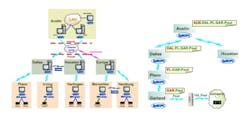Distributed Data Collection with OPC
The progress of world globalization is influencing the economics of multiple countries, providing a strong impulse for the merger and absorption of companies, and resulting in the creation of large-scale financial and industrial holdings and multinational corporations. Because of this, a new class of objective information flows from local automation systems for the engineering processes.
Solving these objectives presents numerous difficulties due to the incompatibility of local systems data communication protocols. In most cases, it appears to be a matter of unification of geographically distributed systems.
Each company, facing the need to solve such problems, has to answer the question of economic expediency, which is the relation between expenses for construction of the unified information system and possible economic benefits from the integration.
These problems generated the first unified standard for organization of data collection and communication in industrial automation systems, called OPC, an open communications interface standard. Along with its obvious advantages, OPC technology poses a number of challenges in the use of the standard as the basis for constructing scaled, geographically distributed Automated Workflow Control Systems.
First of all, there is the issue of organizing data links to transmit data from data suppliers (controllers, data collection units), through hierarchical levels of the system, which may be separated by hundreds of kilometers. In many cases, existing data links are not high quality and reliable ones, while the creation of specialized communication lines is impossible for economic reasons. This means that the software responsible for information interchange between objects of the system must be able to stably transmit large volumes of information, automatically respond to frequent impacts, and independently choose the shortest routes for data transmission.
The next issue arises in connection with the choice of a protocol for data communication. It is advisable to have an open, prevalent standard, supported by the majority of independent creators of equipment and software. The OPC standard became a universal one after the solution of some problems related to COM/DCOM operation. This solution was found with development of new software products, called communication OPC servers.
Some of the major advantages of SplitOPC are its high capability and stability when it deals with big data volumes transferred through communication links of low quality.
SplitOPC has a number of unique features, allowing it to become the basis for geographically, hierarchically and administratively distributed systems of control and data collection on a real-time scale. These include:
• "End-to-end" data communication, irrespective of the nodes in various segments of the local/global network, with consideration of the installed firewalls
• Determination and creation of a new data access route, in case the old one is broken (dynamic rerouting)
• "Hot" swap with automatic catch-up of the controller, in case the mainstream server breaks down (server duplication is required)
• Cryptographic protection of any segments of Internet traffic with an arbitrary long key
• Support of global alias tables of OPC tags, which allows the creation of an alias for signals, already existing in the system, making it easier to attach available Automated Control Systems
• The system of signal naming, which allows a unique name to be given to each signal, is constructed similarly to the Domain Name Structure (DNS), permitting the precise determination of which level data should be attributed
• High rate of transmitting a large number of tags (up to 200,000) in real-time operation mode, through the use of unique compressing algorithms
• Guaranteed time for the telecontrol transmission, integrated priority system
• Definition of rights (reading, recording) for access to certain groups of signals.
The figures illustrate an example of the construction of the distributed data communication system and how the global alias tables and the system of signal naming help to "order" the structure of signal names.
The wide range of functions and high reliability of SplitOPC contribute to its popularity. In particular, by the beginning of 2005 in Russia and contiguous countries, dozens of distributed control and data collection systems had been implemented on the basis of SplitOPC (such as telecontrol, dispatch control and monitoring systems, oil registering packs, Automated Workflow Control Systems for distributed objects and others), and more than 300 copies of the product had been installed. Among prominent users are such respected companies as Transneft, Lukoil, Rosneft, Yukos, Sibneft, Tatneft and others.
SplitOPC communication server allows the creation of a hierarchically distributed data collection system without considerable expenditures, by connecting various sources of information and following common standards.
Its fourth version is available for downloading on the project site www.splitopc.ru. The temporary license allows users to start and try all the features of SplitOPC for a 30-day period.
For more information about SplitOPC from PROSOFT-Systems, visit www.splitopc.ru.

